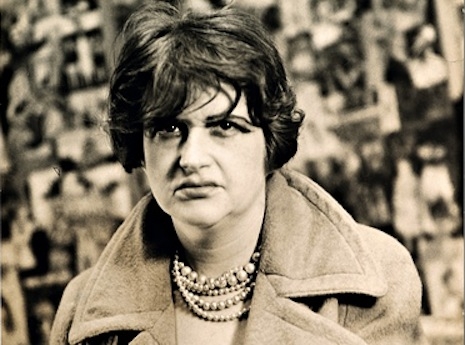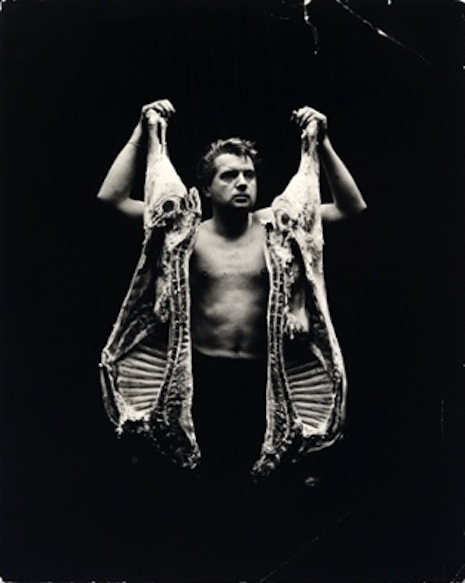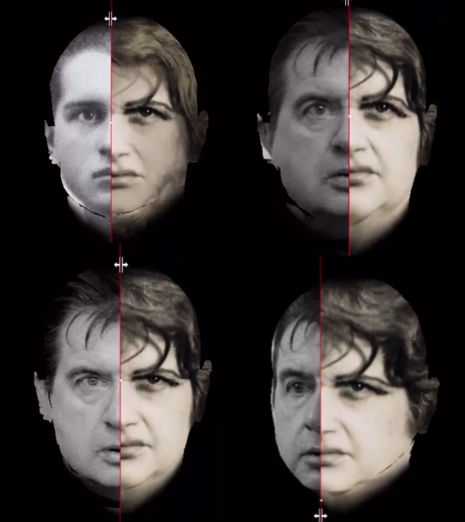
“Unknown woman, 1930s” (detail)—is this Francis Bacon in drag?
In April of this year, the British newspaper The Guardian ran a gallery of photos by John Deakin, a well-known British photographer from the postwar era who was part of the Soho circle of artists and writers centered around the Colony Room, a private drinking club, that included Francis Bacon, Lucian Freud, and J.P. Donleavy. Deakin worked on and off for Vogue, but his alcoholism and tempestuous personality ruled out sustained employment. Deakin had aspirations to be a painter, like Freud and Bacon, but his most resonant work came as a photographer; he died in near-obscurity in 1972, but his reputation has blossomed since then. The Guardian ran the gallery as a tie-in to a retrospective of Deakin’s work, “John Deakin and the Lure of Soho,” at the Photographers’ Gallery in London that will be on through July 20.

“Unknown woman, 1930s”
The final picture of the Guardian’s gallery of 12 pictures was titled “Unknown woman, 1930s.” Commenter bullshotcrummond pointed out that a press release had identified the image as “Transvestite, 1950s.” In response, another commenter, congokid, replied, “Or is it Bacon in drag?” At this point, Paul Rousseau, collection manager of the John Deakin Archive, decided to give the image a second look. He quickly determined that congokid’s remark might have merit. “I’d never considered it before, annoyingly,” he said.
Searching through the archive, he was able to establish that the photo was one of a set dated 1945 (making them some of the oldest in the Deakin collection), possibly taken for Lilliput magazine, a publication with a reputation for risque photography. There were 15 images in all, and Rousseau immediately set about establishing who the models might be. “I quickly landed on his closest friends Denis Wirth-Miller and Richard (Dickie) Chopping. Denis was a painter and Dickie was semi-famous for designing the original dustjackets for the James Bond books.”
“Dickie was known to love dragging up; he was dame every year at the RCA when he became a lecturer there in 1962. And there are many references to Bacon’s interest in drag, his wearing of women’s knickers and stockings.”
Using facial recognition software developed by the CIA, Rousseau produced videos which show that the similarity between Deakin’s cross-dressing sitters and these men is, if not conclusive, then certainly startling.
The question of the identity of the photograph’s subject touches on issues of taboo and criminality of the era. Before the Sexual Offences Act of 1967, which decriminalized homosexuality in the UK, pictures of men in drag were used in prosecutions against gay men. As a results, Deakin’s vague labeling of the photo and the fact that he never published the photo in his lifetime may relate to the important ramifications that distributing it might have incurred. As the Guardian notes, “By never publishing the photos, Deakin may have posthumously undermined his reputation as the nastiest man in Soho.”

The similarity in the facial structure is compelling, to be sure, but there is a picture of a bare-chested Bacon dating from 1952 in the same Guardian gallery in which “Unknown woman, 1930s” appears. In that picture, he looks, to my eye, a good deal younger than the person in the “drag” picture, which Rousseau has dated as 1945.
There is also the question the Guardian brings up, namely that of “cleavage”:
While the face is very much like Bacon’s and the mole on the model’s chest closely matches that which can be seen in the famous picture of Bacon holding two sides of meat, it is impossible to ignore the substantial cleavage.”
“Deakin was known to fiddle about with photos using basic overpainting techniques,” says Rousseau. “Or did Bacon learn to manipulate his ‘moobs’ like that from his years in Weimar Berlin?”

Here are four brief videos by YouTube user jerseyrousseau, who is presumably Paul Rousseau, comparing “Unknown Woman, 1930” to various photographs of Bacon.